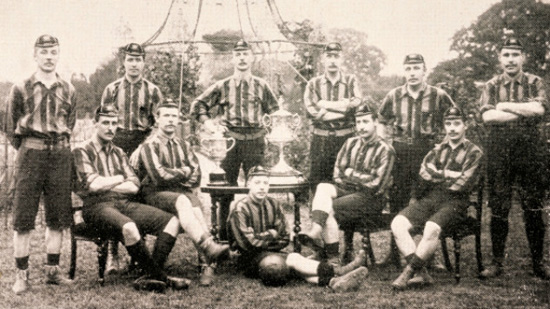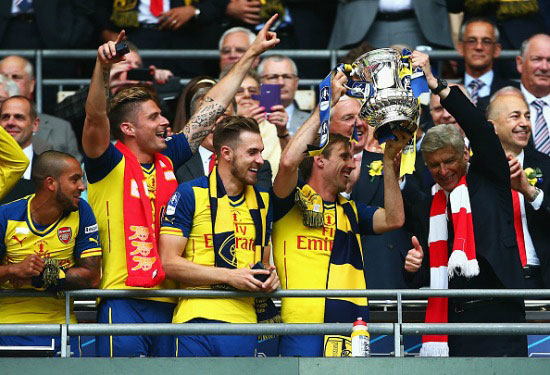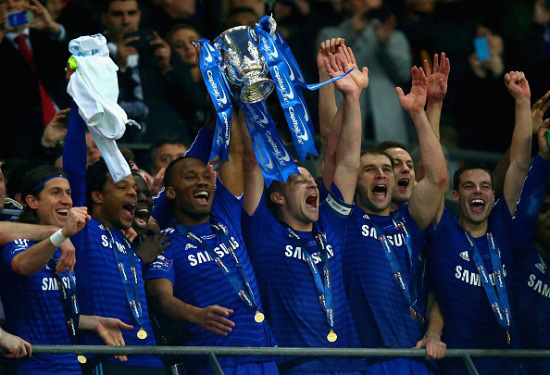Soccer Primer: What's the Difference Between the FA Cup and the League Cup?
Posted Thursday, November 05, 2015 by watoday.com.au

There are hundreds of soccer leagues spread across the face of the globe, and each country has its own understanding of and terminology for the beautiful game. With so many factors at play, there are always big questions to answer. However, it’s the smaller ones that tend to slip through the cracks. These are the types of conundrums we at Paste seek to answer in our weekly Soccer Primer.
Question: What’s the Difference Between the FA Cup and the League Cup?
Bonus Question: Why does one appear to be significantly more important than the other?
Everyone who is even nominally familiar with European soccer knows the English Premier League and the UEFA Champions League. Fewer fans might have such a familiarity with the FA Cup (now the Emirates FA Cup), and fewer still with the League Cup (also known as the Capital One Cup). So what are these latter two competitions, why do they exist, and are they actually important?
The Emirates FA Cup

The FA Cup is, as any self-respecting English gentleman will inform you, the oldest association football competition in the world. Simply put, it’s the oldest club soccer tournament on the planet. Started in 1871, the FA Cup is now open to every team competing in the top ten levels of the English league system (from the giants of the Premier League to the less-than-giants of the Spartan South Midlands League).
This year, a total of 736 clubs (including the six Welsh sides competing in England) registered for the tournament, which is organized into a total of 14 rounds. The first six rounds, dubbed “the qualifying rounds” feature the lowest ranked teams in the tournament, with teams from stronger leagues added at each phase. After qualifying come the six “proper” rounds, which is where the big boys get introduced. Clubs from League One and League Two arrive in the first round proper, while Premier League and Championship sides don’t enter the fray until the third round.
At the end of this somewhat bloated competition sits the FA Cup Final, wherein the champions are rewarded with automatic entry into next season’s Europa League, a place in the Community Shield (the season opening friendly between the winners of the Premier League and the FA Cup), and a decent chunk of change. Indeed, as reported by The Daily Mail, as a result of the three-year, £30 million sponsorship deal with Emirates Airlines, the prize money for winning the tournament this season will be in excess of £1.8 million, and that’s without TV revenue factored in. Dan Walker of the BBC calculated that when Arsenal won the competition in the 2013-2014 season, the club netted £4.2 million from prize money and TV rights combined. That might seem like a lot, except Arsenal also earned £93 million from the Premier League and £23 million from the Champions League. In fact, income from the successful FA Cup campaign accounted for less than 2% of Arsenal’s £302 million revenue that year.
Despite this relatively paltry sum, the FA Cup remains an attractive piece of silverware largely because of its reputation. In its 144-year history, the FA Cup has been won by 43 clubs (two of which no longer exist). Since the 1979-1980 season, only 11 clubs have won the competition. Though there are some outliers like Portsmouth (2007-2008 champions) and Wigan (2012-2013), only the biggest clubs tend to win the tournament. Such is its import that, when Arsene Wenger won the FA Cup in the 2013-2014 campaign, it was widely acknowledged that he had finally gotten a nine-year old trophyless monkey off of his back. Thus, the FA Cup might not pack the most resounding financial wallop, but it still carries the weight of history behind it.
The Capital One Cup

The League Cup has numerous elements in common with its big brother, but it’s the few distinct differences that make it the “also ran” in terms of cup glory. While it is a single elimination tournament played by teams in England and Wales, the League Cup only includes the 92 clubs currently in the top four English leagues. There’s something decidedly less awe-inspiring about a tournament involving 92 clubs instead of 736. The tournament itself consists of seven total rounds, with sides competing in Europe receiving byes until the third round, Premier League teams entering in the second, and the rest of the competing clubs kicking off the first round of action. The eventual champion earns prize money and, as with the FA Cup, automatic qualification to the Europa League.
The League Cup is less historically important. The FA Cup was created at a time when there were no unified leagues, so it represented the only avenue for clubs from different parts of the country to meet. In contrast, the League Cup began in 1960 (89 years after its aged counterpart), the result of a determined effort to curb waning attendance figures at league fixtures. The brains behind the League Cup cleverly pointed out that 1) most clubs in the top leagues had installed flood lights by 1960, 2) league and FA Cup matches were played on the weekends, and 3) those afore-mentioned lights pretty much sat dormant the rest of the time.
Thus, the League Cup was introduced in 1960 specifically as a tournament that would be played on weekday evenings under the bright lights. While this move initially boosted interest, the growth of midweek league games and more enticing European fixtures has now made an already crowded schedule even less manageable. Thus, many managers utilize the League Cup as an opportunity to experiment with new tactics, rest veterans and give debuts to promising youngsters.
In the 55-year history of the League Cup, 23 clubs have been crowned champions. However, the six clubs with the most League Cup victories (Liverpool, Aston Villa, Chelsea, Manchester United, Tottenham and Nottingham Forest) have combined to win the competition 22 times (that’s five more than the next 17 combined). In fact, the competition could justifiably be named the Ian Rush Cup, given that the Liverpool legend managed to win it on five different occasions.
Finally, there is the prize money, or a relative lack thereof. When Chelsea won the 2014-2015 iteration, the club was rewarded with the staggering reward of £100,000. For its part, runner-up Tottenham received £50,000. To put those figures in an accounting perspective, they constitute .031% and .028% of overall club revenue, respectively. To put those figures in a horrifying perspective, they are 1/3 and 1/6, respectively, of what Wayne Rooney earns in a week.
Looking Ahead

Although both the FA Cup and the League Cup represent valuable and worthwhile competitions on paper, in reality they have been become less relevant in recent years (at least for those teams competing in the Premier League). As a result of increasingly lucrative TV deals, for the 2014-2015 season, every Premier League club was guaranteed at least £54.1 million in broadcast fees. After adjusting for additional facts and figures, champions Chelsea earned £98.99 million, while last place QPR had to survive on a paltry £64.8. With so much cash flowing into the coffers of the already rich, it’s unlikely that the miniscule prize money offered by domestic cup competitions will do much to interest managers hungrily eyeing a higher place in the league table. Last season, the difference in prize money between 10th place Crystal Palace and 11th place Everton was £1.2 million. That’s roughly the equivalent of 1/4 of an FA Cup or an absurd 12 League Cups.
However, to judge the FA Cup solely on its financial contribution to Premier League clubs is unfair. As previously noted, the new sponsorship deal (while soulless and sad) includes increased provisions for teams advancing to each stage of the competition. While a few million might not mean much to a Premier League giant, the £12,500 awarded to a non-League side that makes it out of the qualifying phase is significant. Additionally, although interest in the competition was waned over the years, it remains a celebrated event capable of ensuring a legacy for even the most unlikely of managers (just ask Harry Redknapp).
By contrast, the League Cup’s future is uncertain. Many managers resent it, as it represents another opportunity for a critical player to pick up an unnecessary injury. Others point out that, of the top five leagues in Europe, only England and France have two domestic cup competitions. If La Liga, Bundesliga and Serie A are doing okay with one, why complicate things with yet another cup competition?
As a result of these concerns, a few pundits have proposed alternatives, ranging from adjusting the format of the competition to limit the total number of games, to killing it off outright, to setting age limits on squads to help the competition serve as a showcase for rising talent. Although none of these options would transform the League Cup into a marquee event, the third possibility would see it morph into something far more compelling than a chance to see Arsene Wenger field a team of players, most of whom you were pretty certain he sold ages ago.
- Tag:
- FA Cup
- Premier League
Photos
More»Sizzling pics of Antje Utgaard
Friday November 01 202410 gorgeous WAGs who rocked cheeky Halloween looks
Friday November 01 2024[PICTURE SPECIAL] Como 1 - 5 Lazio
Friday November 01 2024




Your Say